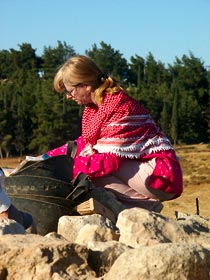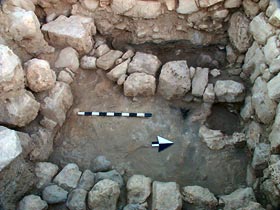Weekly Reports from Jordan
Choose Year: or Choose week
Packing It All In
Larry G. Herr and Douglas R. Clark
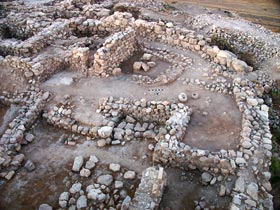 Readers may not realize how busy we are if you visited our camp today for a short time. That's because the frenzy hits at weird times. Or maybe it's because the leaders have been through all of it many times before. But the final week of an excavation, known as "closedown," is usually filled with frantic comings and goings that include celebrating special dig-end parties, packing up crates for the shipment, taking the last photos, getting the object registry finalized for the Department of Antiquities, moving everything to the storeroom, fighting illness due to overwork, and changing daily schedules every day!
Readers may not realize how busy we are if you visited our camp today for a short time. That's because the frenzy hits at weird times. Or maybe it's because the leaders have been through all of it many times before. But the final week of an excavation, known as "closedown," is usually filled with frantic comings and goings that include celebrating special dig-end parties, packing up crates for the shipment, taking the last photos, getting the object registry finalized for the Department of Antiquities, moving everything to the storeroom, fighting illness due to overwork, and changing daily schedules every day!
Yes, all that is happening this season, too, but this year's crew has been extremely helpful. We are working like a true team. As we write, most things have already been accomplished. There is yet only the move by truck of the digging tools from the tell to camp, the front loader and the removal of sift piles at the site by front loader, and the move of all camp supplies to the storeroom on Friday. Most reports are written, all balks are drawn, and only bits and pieces remain to complete a few square notebooks.
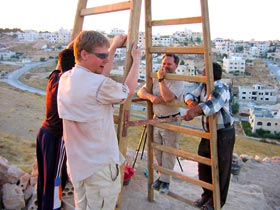 The excitement of final photos is over with Field B on Wednesday night. These photos are often taken with the five-meter-tall A-frame ladder that takes at least four people to carry. People anchor the ladder by standing on the bottom rung while intrepid Doug Clark ascends to the top for a "fantastic" view of each field. This was especially so in Fields A and B when the ladder was placed on the roof of the reconstructed four-room house, making Doug's perch about eight meters above the ground.
The excitement of final photos is over with Field B on Wednesday night. These photos are often taken with the five-meter-tall A-frame ladder that takes at least four people to carry. People anchor the ladder by standing on the bottom rung while intrepid Doug Clark ascends to the top for a "fantastic" view of each field. This was especially so in Fields A and B when the ladder was placed on the roof of the reconstructed four-room house, making Doug's perch about eight meters above the ground.
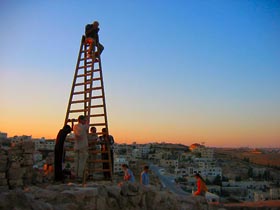 |
 |
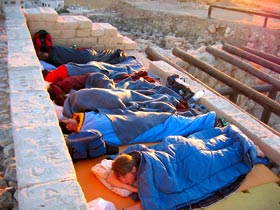 Some teams simply don't want to quit! Diggers in Field B, frantically trying to remove the destruction debris inside the exceptionally well preserved Late Bronze Age palace/temple, wanted to have their cake and eat it too! In order to clear the destruction debris, they were forced to leave earlier in the morning than others and arrive much later than others. They even spent an extra afternoon in the dust sweeping things down. Seven of them even slept overnight on the roof of the four-room house on Wednesday (four the night before). They insist they slept better than those of us in the dorms.
Some teams simply don't want to quit! Diggers in Field B, frantically trying to remove the destruction debris inside the exceptionally well preserved Late Bronze Age palace/temple, wanted to have their cake and eat it too! In order to clear the destruction debris, they were forced to leave earlier in the morning than others and arrive much later than others. They even spent an extra afternoon in the dust sweeping things down. Seven of them even slept overnight on the roof of the four-room house on Wednesday (four the night before). They insist they slept better than those of us in the dorms.
And the sweeping! Most newcomers don't realize how much cleaning goes into a dig. Until they do it, that is! The final photos must be picture perfect with stones polished by many brush strokes so they jump out at the camera. Even the dirt must be "swept" so that no foot prints remain to mar the picture (they really seem to stand out!) and every earthen surface must also be polished with the brush. Sometimes teams of 12 people may spend a complete day brushing their field and then spend another hour giving it a once-over polish immediately before the photo.
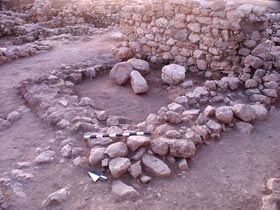 But the finds, and the work by the digging teams on them, have been well worth all the work. In Field A (Bob Bates, field supervisor) the three northern teams (Tom Venner, Heather Merizan, Kassie Skoretz, Caroline Houghton, Steve Salcido, Deborah Haberman, and Aaron Davis) successfully removed all the complex deposits around the four walls of a late Iron 1 room and dismantled three of the walls stone by stone. They broke scores of large stones with sledge hammers in order to accomplish this. The only wall remaining is part of a house farther to the east. Their goal had been to reach the top of the early Iron 1
But the finds, and the work by the digging teams on them, have been well worth all the work. In Field A (Bob Bates, field supervisor) the three northern teams (Tom Venner, Heather Merizan, Kassie Skoretz, Caroline Houghton, Steve Salcido, Deborah Haberman, and Aaron Davis) successfully removed all the complex deposits around the four walls of a late Iron 1 room and dismantled three of the walls stone by stone. They broke scores of large stones with sledge hammers in order to accomplish this. The only wall remaining is part of a house farther to the east. Their goal had been to reach the top of the early Iron 1  destruction (from about 1200 BC) in a large area. This they did with perfect success. But in so doing, they also discovered new walls from earlier phases, including a nicely formed doorway that had been later blocked up. One of the walls is unique at the site in that it sports an S-curve. With approximately 50 loci this season, Caroline Houghton claims the record for the most loci within a season. The average number of loci per square in any given season is 20-25. Talk about bookwork! And it was all done with a cheerful spirit!
destruction (from about 1200 BC) in a large area. This they did with perfect success. But in so doing, they also discovered new walls from earlier phases, including a nicely formed doorway that had been later blocked up. One of the walls is unique at the site in that it sports an S-curve. With approximately 50 loci this season, Caroline Houghton claims the record for the most loci within a season. The average number of loci per square in any given season is 20-25. Talk about bookwork! And it was all done with a cheerful spirit!
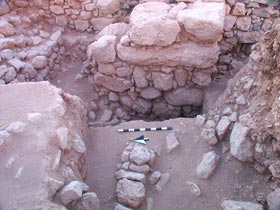 The southern team in Field A (Audrey Shaffer, Derek Bobst, Erica Hufnagel, Brenda Adams, Tyler Mitchell, and Amy Bellinghausen) warmed Larry Herr's heart by discovering the gate into the site during the Iron 1 period (1200-1000 BC). We had been searching for this gate for 10 seasons and have finally found it, thanks to their work. And it was a dramatic discovery, because it occurred along with the discovery of the largest stone so far found at the site, a whopping 2.3 meters (ca. 8 feet) long, 50 cm wide (ca. 1.5 feet), and 55 cm thick. We estimate its weight at about 1,100 kg (ca. 2,220 pounds). It was one of the corner stones in the projecting terminal point of the southern wall of the gate. A short pier projects into the gateway area, allowing the ancient inhabitants to have better control of people entering the city. Next season will provide a better plan of the gate.
The southern team in Field A (Audrey Shaffer, Derek Bobst, Erica Hufnagel, Brenda Adams, Tyler Mitchell, and Amy Bellinghausen) warmed Larry Herr's heart by discovering the gate into the site during the Iron 1 period (1200-1000 BC). We had been searching for this gate for 10 seasons and have finally found it, thanks to their work. And it was a dramatic discovery, because it occurred along with the discovery of the largest stone so far found at the site, a whopping 2.3 meters (ca. 8 feet) long, 50 cm wide (ca. 1.5 feet), and 55 cm thick. We estimate its weight at about 1,100 kg (ca. 2,220 pounds). It was one of the corner stones in the projecting terminal point of the southern wall of the gate. A short pier projects into the gateway area, allowing the ancient inhabitants to have better control of people entering the city. Next season will provide a better plan of the gate.
The same team also discovered a later adaptation to the gate with a wall built along the passageway of the gate, restricting the width of the entrance. The bottom of the wall has not yet been found so we can't date it yet. But to reach the gate the team had to remove several Iron 2 walls whose builders completely ignored it. Indeed, somewhat farther into the city and built right across the passage of the gate was the late Iron 2 Ammonite administrative complex we had extensively excavated during the 1980s. (The Iron 2 settlement had not did not have walls and therefore needed no gate.
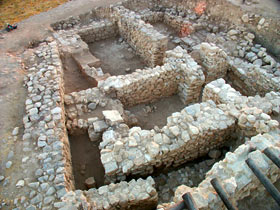 Diggers in Field B (Kent Bramlett, field supervisor) almost, yes almost, revealed the complete floor of the northern rooms of the Late Bronze Age palace/temple we have been digging since 1996. This had been their goal from day one, and they have worked toward it with unusual focus and determination, even working many extra hours toward the end and pushing many of our limits as they bring in finds at the last moment (or a bit after the last moment!).
Diggers in Field B (Kent Bramlett, field supervisor) almost, yes almost, revealed the complete floor of the northern rooms of the Late Bronze Age palace/temple we have been digging since 1996. This had been their goal from day one, and they have worked toward it with unusual focus and determination, even working many extra hours toward the end and pushing many of our limits as they bring in finds at the last moment (or a bit after the last moment!).
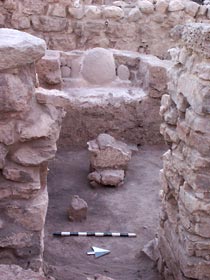 But the end result has been stellar. We now have two phases of floors in the largest room and the entrance hall. The earliest floor was found first by Ellen Bedell and Bethany Reiswig in the northern part of the largest room (the one with the cultic niche). The group excavating the southern part (Janelle Worthington, Matt Vincent and Lindsey Hill) soon found it, too, and confirmed that it was associated with a series of stones forming a bench along one of the walls and saw the blockage of one of two doors entering the room from the entrance hall. Because of the number of small finds on the floor, however, they had to stop excavation with the upper floor. They also discovered a small plastered presentation altar immediately in front of the cultic niche. Next season we will excavate to the lower floor, while protecting the niche, its wall and the altar with a protective cover of sand and cinder blocks.
But the end result has been stellar. We now have two phases of floors in the largest room and the entrance hall. The earliest floor was found first by Ellen Bedell and Bethany Reiswig in the northern part of the largest room (the one with the cultic niche). The group excavating the southern part (Janelle Worthington, Matt Vincent and Lindsey Hill) soon found it, too, and confirmed that it was associated with a series of stones forming a bench along one of the walls and saw the blockage of one of two doors entering the room from the entrance hall. Because of the number of small finds on the floor, however, they had to stop excavation with the upper floor. They also discovered a small plastered presentation altar immediately in front of the cultic niche. Next season we will excavate to the lower floor, while protecting the niche, its wall and the altar with a protective cover of sand and cinder blocks.
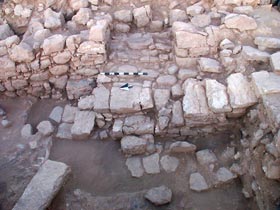 The two teams excavating the entrance hall also had an exciting time. Carolyn Waldron and Katie Van Petten uncovered the northern wall of the room, as well as the northeast corner of the building. Another team (Monique Acosta and Boris Brajnikoff) have been clearing the monumental entrance to the building, complete with orthostat stones (stones standing on edge) lining the entrance and a series of steps. As a result of their work we now know that a person entering the building would descend from the outside (probably from above Middle Bronze Age remains) by a series of steps to a landing. Here they could chose to turn left and ascend more steps to the second story, turn right and descend three more steps to the floor of the hall near the northern door into the cult room, or proceed straight ahead going down another three steps to the floor winding up near the southern door of the cult room.
The two teams excavating the entrance hall also had an exciting time. Carolyn Waldron and Katie Van Petten uncovered the northern wall of the room, as well as the northeast corner of the building. Another team (Monique Acosta and Boris Brajnikoff) have been clearing the monumental entrance to the building, complete with orthostat stones (stones standing on edge) lining the entrance and a series of steps. As a result of their work we now know that a person entering the building would descend from the outside (probably from above Middle Bronze Age remains) by a series of steps to a landing. Here they could chose to turn left and ascend more steps to the second story, turn right and descend three more steps to the floor of the hall near the northern door into the cult room, or proceed straight ahead going down another three steps to the floor winding up near the southern door of the cult room.
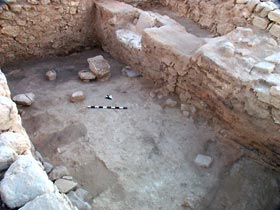 An interesting feature about this building has been the combination of brick and stones in the same wall, especially in the wall containing the cultic niche and in a similar wall to the south. Just why the ancient builders used this type of construction evades the best of our imaginative cogitations, as yet.
An interesting feature about this building has been the combination of brick and stones in the same wall, especially in the wall containing the cultic niche and in a similar wall to the south. Just why the ancient builders used this type of construction evades the best of our imaginative cogitations, as yet.
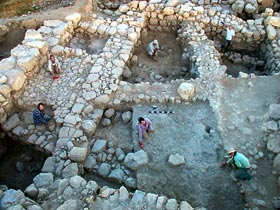 In Field H (Dave Berge, field supervisor) diggers have removed most of the earliest cobble floor of the open-air sanctuary, revealing the had-packed layers that supported the cobble surface and covered late Iron 1 ruins below about 60 cm (ca. 23 inches) of debris. One square dug by Don Mook, Larry Murrin, Jill Logee, and Erin Carr have uncovered parts of three walls, a beaten-earth surface, and an oven made of clay from the Iron 1 period. The other teams (Jeannie DelColle, Stefanie Elkins, Julie Cormack, Barbara Trip, Nikki Oakden, Marcin Czarnowicz, and Aga Ochal) have all reached Iron 1 levels, but must wait until next season to uncover domestic architecture and floors.
In Field H (Dave Berge, field supervisor) diggers have removed most of the earliest cobble floor of the open-air sanctuary, revealing the had-packed layers that supported the cobble surface and covered late Iron 1 ruins below about 60 cm (ca. 23 inches) of debris. One square dug by Don Mook, Larry Murrin, Jill Logee, and Erin Carr have uncovered parts of three walls, a beaten-earth surface, and an oven made of clay from the Iron 1 period. The other teams (Jeannie DelColle, Stefanie Elkins, Julie Cormack, Barbara Trip, Nikki Oakden, Marcin Czarnowicz, and Aga Ochal) have all reached Iron 1 levels, but must wait until next season to uncover domestic architecture and floors.
 In Field L (David Hopkins and Mary Boyd, field supervisors) seems to have come down to the top of the late Iron 2 level (ca. 600 BC). They proved that the Hellenistic farmstead, so prominent in squares farther to the west, was much less apparent in the east. The team here (Ruth Kent, Azadeh Vafaradi, and Ferdinand Regalado) found patches of the Hellenistic plaster floor known to the west and caught part of a stone-lined drain that was a prominent feature to the west. But nothing west farther than about two meters before disappearing. Just emerging, however, are three boulders with holes in them, suggesting they may have been used as weights in an olive oil press (or similar) industry. Such presses are well known in the Iron Age. Next season should tell all. In another square they found the top of a huge wall made of very large boulders, some two meters long!
In Field L (David Hopkins and Mary Boyd, field supervisors) seems to have come down to the top of the late Iron 2 level (ca. 600 BC). They proved that the Hellenistic farmstead, so prominent in squares farther to the west, was much less apparent in the east. The team here (Ruth Kent, Azadeh Vafaradi, and Ferdinand Regalado) found patches of the Hellenistic plaster floor known to the west and caught part of a stone-lined drain that was a prominent feature to the west. But nothing west farther than about two meters before disappearing. Just emerging, however, are three boulders with holes in them, suggesting they may have been used as weights in an olive oil press (or similar) industry. Such presses are well known in the Iron Age. Next season should tell all. In another square they found the top of a huge wall made of very large boulders, some two meters long!
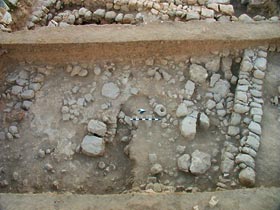 But this field, as we wrote last week, produced by far the largest amount of objects, giving us over 480 for the complete season.
But this field, as we wrote last week, produced by far the largest amount of objects, giving us over 480 for the complete season.
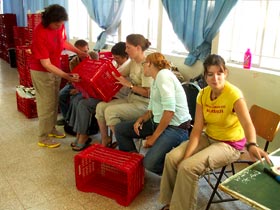 This week marks the end of field work and life in camp. Friday saw members of the team along with our workers from Bunayat moving all of our equipment back into the storeroom. This means repacking everything, sorting equipment, schlepping crates and tools across campus and up three flights of stairs, both external and internal, and stacking things in an orderly fashion. This phase of our work tells a lot about us following five and a half weeks in the sun.
This week marks the end of field work and life in camp. Friday saw members of the team along with our workers from Bunayat moving all of our equipment back into the storeroom. This means repacking everything, sorting equipment, schlepping crates and tools across campus and up three flights of stairs, both external and internal, and stacking things in an orderly fashion. This phase of our work tells a lot about us following five and a half weeks in the sun.
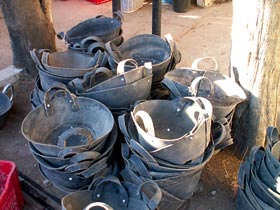 |
|
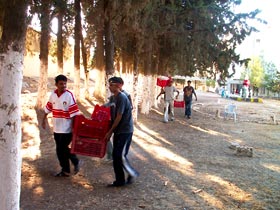 |
|
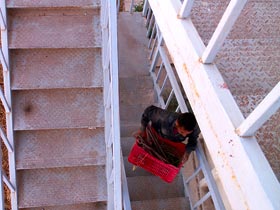 |
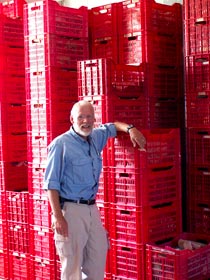 |
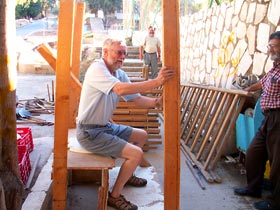 |
|
Following camp shut-down, most of the team will wend their way to Aqaba for a relaxing time in the sun, sand and sea. We will, of course, be experiencing temperatures similar to those of the North American heat waves this summer (ca. 41 degrees C or 105 degrees F), but we will enjoy the beaches, snorkeling, night shopping, and tours of the stunning scenery in the Wadi Ram. After that, most of us will return to Amman to await our flights home.
After a full season of digging, what is the single most interesting thing we have found? Larry likes to insist that this is never an object or a small find. Rather, he likes to say, it's usually an earth layer! And because he's writing this, he will insist that that is again the case this season. Well, almost. Rather, it's a series of earth layers. It has to be our emerging realization of the importance of Tall al-`Umayri during the Iron 1 period, the time of the biblical judges. Excavations this season, except for Field B, have attained that level almost everywhere (only slightly in Field L). There is a stupendous gate in Field A, a significant and deep destruction layer in Field A, several phases of it in Field H (and A and B in earlier seasons), and very large walls and stone construction in Fields A, H, and L.
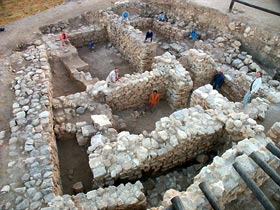 Second to this change in our thinking about the site has to be the LB palace/temple, the best preserved building from this time period in the Holy Land. In fact, it's so well preserved (with walls as high as most of those at Pompeii, but 1500 years earlier!) that it's very difficult to take good pictures of the building.
Second to this change in our thinking about the site has to be the LB palace/temple, the best preserved building from this time period in the Holy Land. In fact, it's so well preserved (with walls as high as most of those at Pompeii, but 1500 years earlier!) that it's very difficult to take good pictures of the building.
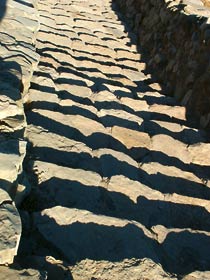 We are winding down and many of us are already prepared to move on. We don't want to eat any more watermelon until next season. Even felafels don't sound very good by now. And rice, don't let us near any rice for at least another two months. And it goes without saying that neither cream of wheat nor oatmeal will be caught in our breakfast bowls when we arrive home! But we have all been part of a very successful team of discovery. Although the site and its mysteries lie in Jordan, we carry a large part of it and its discoveries in our minds and memories. And its ever generous, eternally hospitable people in our hearts. Come to Jordan next season to experience what we have. Ahlan w'Sahlan, Welcome. The tell's grand entry stairs are here for you. We are extending this invitation to you.
We are winding down and many of us are already prepared to move on. We don't want to eat any more watermelon until next season. Even felafels don't sound very good by now. And rice, don't let us near any rice for at least another two months. And it goes without saying that neither cream of wheat nor oatmeal will be caught in our breakfast bowls when we arrive home! But we have all been part of a very successful team of discovery. Although the site and its mysteries lie in Jordan, we carry a large part of it and its discoveries in our minds and memories. And its ever generous, eternally hospitable people in our hearts. Come to Jordan next season to experience what we have. Ahlan w'Sahlan, Welcome. The tell's grand entry stairs are here for you. We are extending this invitation to you.
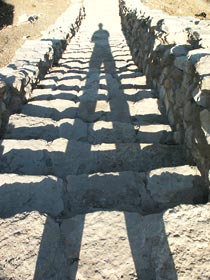 A heads-up: Watch the MPP-`Umayri website "Jordan Updates" for photo galleries of people and discoveries. It will take some time to get everything posted we hope to, but check it during the next week or so.
A heads-up: Watch the MPP-`Umayri website "Jordan Updates" for photo galleries of people and discoveries. It will take some time to get everything posted we hope to, but check it during the next week or so.
Overheard:
"Tomorrow, are we going to be doing anything dirty?" – Boris Brajnikoff to his Field supervisor, Kent Bramlett, ostensibly anticipating another day of dust and glory.
"Only 5% of our students create problems for us and we want to make that number smaller through conversation and understanding." – Dr. Saleh Naji, principal of the Amman Training Centre where we live.
"But we are all scholars and are married to our computers." – Doug Clark, pleading with the staff in the education building next to ours, the one in which our internet connections are made after they (occasionally) shut off power to the building when they leave at 3:00 pm each day without leaving a key for anyone else, thereby cutting off our wireless service.
"Does your wife know about this?" – One of the staff in the education building to Doug Clark, hearing that we are married to our computers.
